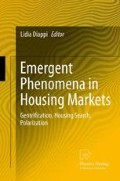Abstract
Multi-Agent systems are a powerful technique to analyse spatially distributed systems of heterogeneous autonomous actors with bounded information and computing capacity who interact locally. A review of recent urban models relying on multi-agent technology learns however that these models at best only start to explore this potential. In this paper, we present a model, simulating the process of residential mobility, fully exploiting the agent-potential, integrating behavioural concepts such as joint-decisions making, bounded rationality, pro-active reasoning, cognitive mapping, etc. We will discuss the conceptual framework, analyse some numerical results and make suggestions as to how to validate such an ‘artificial-society’ model.
Access this chapter
Tax calculation will be finalised at checkout
Purchases are for personal use only
References
Alhashimi H, Dwyer W (2004) Is there such an entity as a housing market? In proceedings of the 10th annual pacific rim real estate conference, Bangkok
Batty M (2005) Cities and complexity: understanding cities with cellular automata, agent-based models, and fractals. MIT Press, Cambridge, MA
Batty M, Torrens P (2005) Modelling and prediction in a complex world. Futures 37:745–766
Bauer B, Müller JP, Odell J (2001) Agent UML: a formalism for specifying multiagent interaction. In: Ciancarini P, Wooldridge M (eds) Agent-oriented software engineering. Springer, Berlin, pp 91–103
Benenson I, Harbash V (2004) Object-based environment for urban simulation, OBEUS user’s guide. Environmental Simulation Laboratory, Tel Aviv University, Israel
Clark WAV, Flowerdew R (1982) A review of search models and their application to search in the housing market. In: Clark WAV (ed) Modelling housing market search. Croom Helm, London, pp 4–29
Clark WAV, Huang Y (2003) The life course and residential mobility in British housing markets. Environ Plann A 35(2):323–339
Clark WAV, Van Lierop WFJ (1986) Residential mobility and household location modelling. In: Nijkamp P (ed) Handbook of regional and urban economics, vol I. Elsevier Science, Amsterdam
Devisch O (2007) In search of a complex-system model, the case of residential mobility. Ph.D. thesis, Eindhoven University of Technology, Eindhoven
Diappi L, Bolchi P (2006) Gentrification waves in the inner-city of Milan. In: Van Leeuwen JP, Timmermans HJP (eds) Innovations in design & decision support systems in architecture and urban planning. Springer, Dordrecht, pp 187–201
Dieleman FM (2001) Modelling residential mobility; a review of recent trends in research. J Hous Built Environ 16:249–265
Dieleman FM, Mulder CH (2002) The geography of residential choice. In: Aragones JI, Garling T (eds) Residential environments: choice, satisfaction, and behavior. Bergin & Garvey, Westport, pp 35–54
Epstein JM (1999) Agent-based computational models and generative social science. Complexity 4(5):41–60
Fransson U, Mäkilä K (1994) Residential choice in a time-space perspective: a micro-simulation approach. Neth J Hous Built Environ 9(3):265–283
Goetgeluk R (1997) Bomen over wonen: woningmarktonderzoek met beslissingsbomen. Ph.D. thesis, Universiteit van Utrecht, Utrecht
Gooch T (2000) Object oriented analysis and design team, Kennesaw State University. http://pigseye.kennesaw.edu/~dbraun/csis4650/A&D/index.htm
Harding JP, Rosenthal SS, Sirmans F (2003) Estimating bargaining power in the market for existing homes. Rev Econ Stat 85(1):178–188
Huff JO (1982) Spatial aspects of residential search. In: Clark WAV (ed) Modelling housing market search. Croom Helm, London, pp 106–129
Lei Z, Pijanowski BC, Alexandridis KT, Olson J (2005) Distributed modeling architecture of a multi-agent-based behavioral economic landscape (MABEL) model. Simulation 81(7):503–515
Lu M (1998) Analyzing migration decisionmaking: relationships between residential satisfaction, mobility intentions and moving behavior. Environ Plann A 30(8):1473–1495
Manson SM (2005) Agent-based modeling and genetic programming for modeling land change in the southern Yucatan peninsular region of Mexico. Agric Ecosyst Environ 111(1):47–62
March JG (1994) A primer on decision making: how decisions happen. The Free Press, New York
McCarthy K (1982) An analytical model of housing search and mobility. In: Clark WAV (ed) Modelling housing market search. Biddles, London, pp 30–53
Molin E (1999) Conjoint modeling approaches for residential group preferences. Ph.D. thesis, Eindhoven University of Technology, Eindhoven
Neapolitan RE (1990) Probabilistic reasoning in expert systems: theory and applications. Wiley-Interscience, New York
Oskamp A (1997) Local housing market simulation, a micro approach. Ph.D. thesis, University of Amsterdam, Amsterdam
Oskamp A, Hooimeijer P (1999) Advances in the microsimulation of demographic behavior. In: van Wissen LJG, Dykstra PA (eds) Population issues: an interdisciplinary focus. Plenum Press, New York, pp 229–263
Otter HS (2000) Complex adaptive land use systems: an interdisciplinary approach with agent-based models. Academic/Eburon, Delft
Parker DC, Manson SM, Janssen MA, Hoffmann MJ, Deadman P (2003) Multi-agent systems for the simulation of land-use and land-cover change: a review. Ann Assoc Am Geogr 93(2):314–337
Portugali J (2000) Self-organization and the city. Springer, Berlin
Simon H (1955) A behavioral model of rational choice. Q J Econ 69(1):99–118
Torrens PM (2001) Can geocomputation save urban simulation? Throw some agents into the mixture, simmer and wait …, CASA working paper series, paper 32, Centre for Advanced Spatial Analysis, University College London, London
van der Vlist AJ, Gorter C, Nijkamp P, Rietveld P (2001) Residential mobility and local housing market differences. Tinbergen institute discussion paper, Tinbergen Institute, Amsterdam
Verhelst M (1980) De praktijk van Beslissingstabellen. Kluwer, Deventer/Antwerp
Waddell P (2001) Towards a behavioral integration of land use and transportation modeling. In: Proceedings of the 9th international association for travel behavior research conference, Queensland
Zhang J, Timmermans HJP, Borgers AWJ (2005) A model of household task allocation and time use. Transp Res B 39(1):81–95
Author information
Authors and Affiliations
Corresponding author
Editor information
Editors and Affiliations
Rights and permissions
Copyright information
© 2013 Springer-Verlag Berlin Heidelberg
About this chapter
Cite this chapter
Devisch, O., Arentze, T., Borgers, A., Timmermans, H. (2013). Employing Agents to Develop Integrated Urban Models: Numerical Results from Residential Mobility Experiments. In: Diappi, L. (eds) Emergent Phenomena in Housing Markets. Physica, Heidelberg. https://doi.org/10.1007/978-3-7908-2864-1_2
Download citation
DOI: https://doi.org/10.1007/978-3-7908-2864-1_2
Published:
Publisher Name: Physica, Heidelberg
Print ISBN: 978-3-7908-2863-4
Online ISBN: 978-3-7908-2864-1
eBook Packages: Business and EconomicsEconomics and Finance (R0)

